Module 5 Unit 1 Don't cross that rope!课件+嵌入音频(共33张PPT)
文档属性
| 名称 | Module 5 Unit 1 Don't cross that rope!课件+嵌入音频(共33张PPT) |  | |
| 格式 | pptx | ||
| 文件大小 | 19.9MB | ||
| 资源类型 | 教案 | ||
| 版本资源 | 外研版 | ||
| 科目 | 英语 | ||
| 更新时间 | 2024-05-14 14:21:19 | ||
图片预览

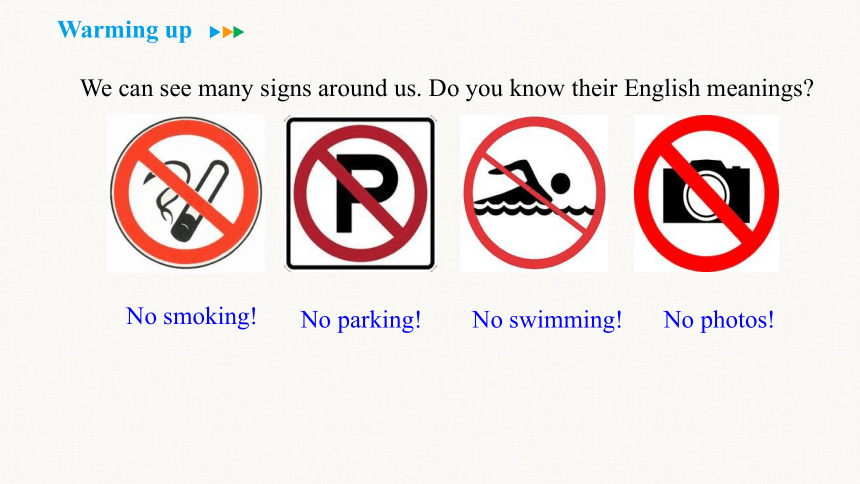
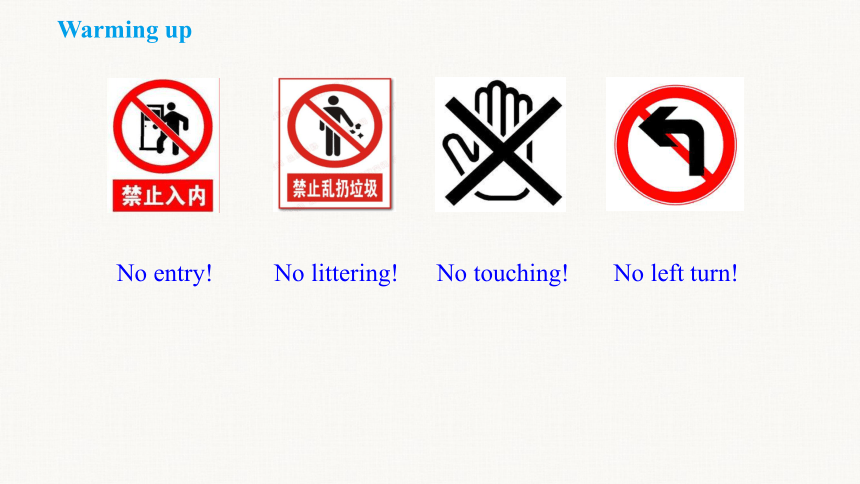
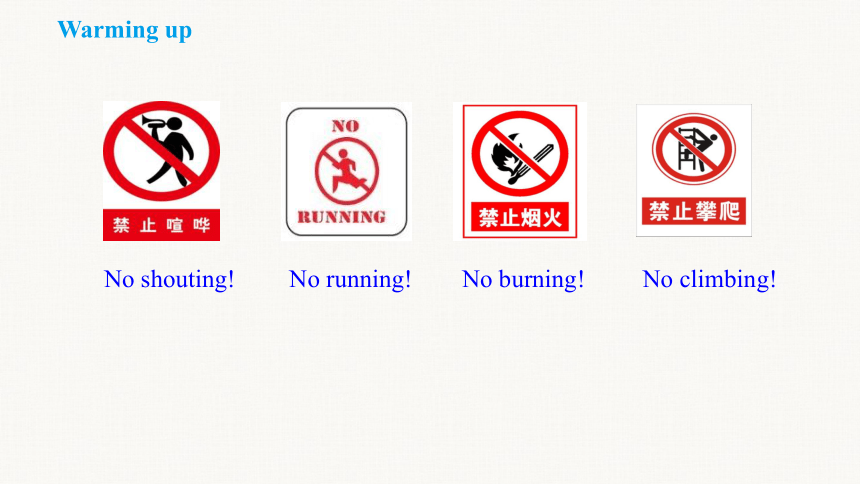
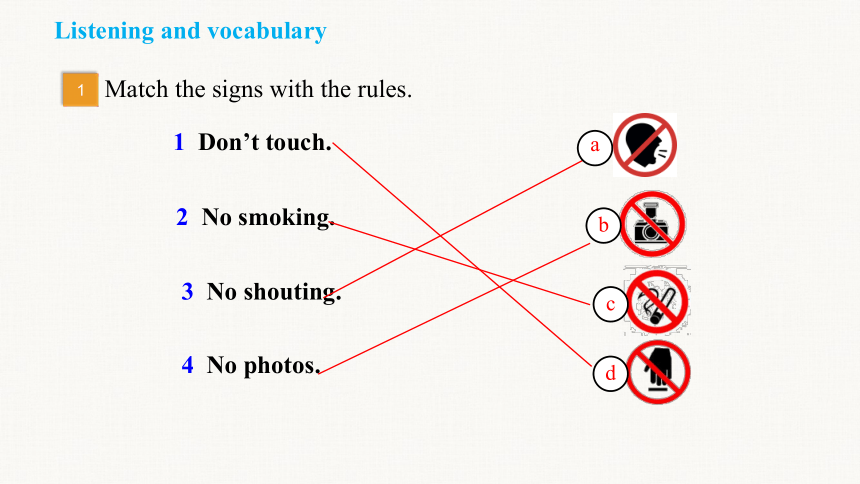
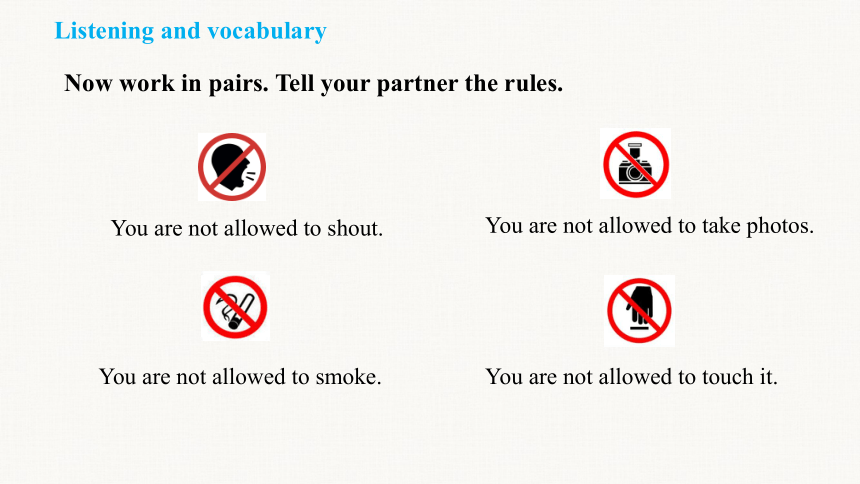
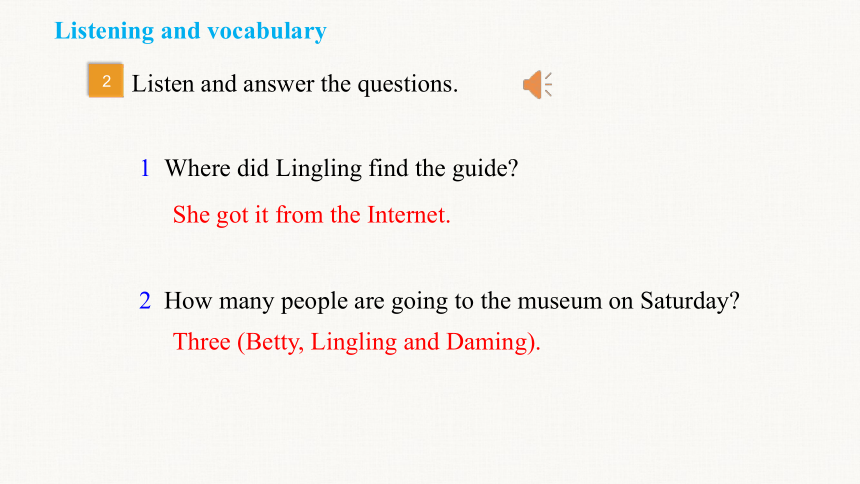
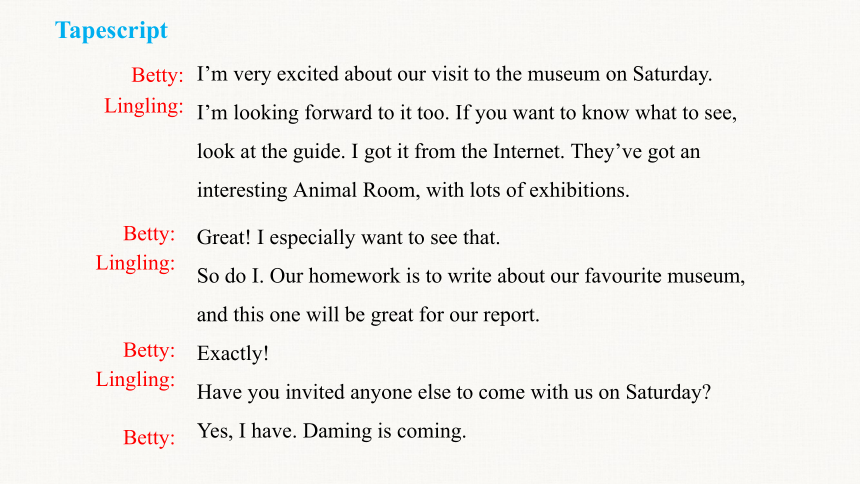
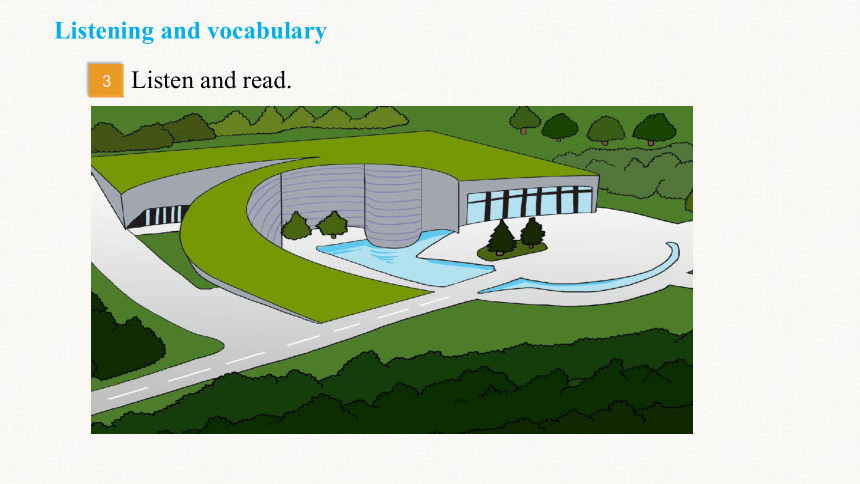
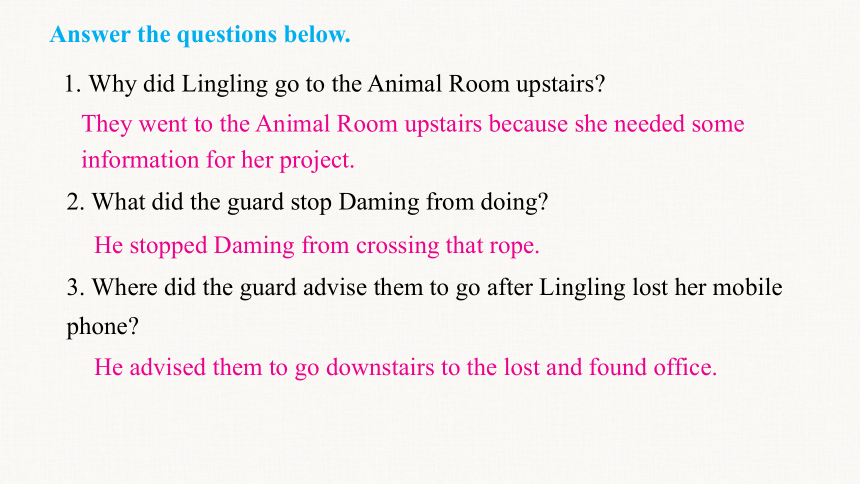
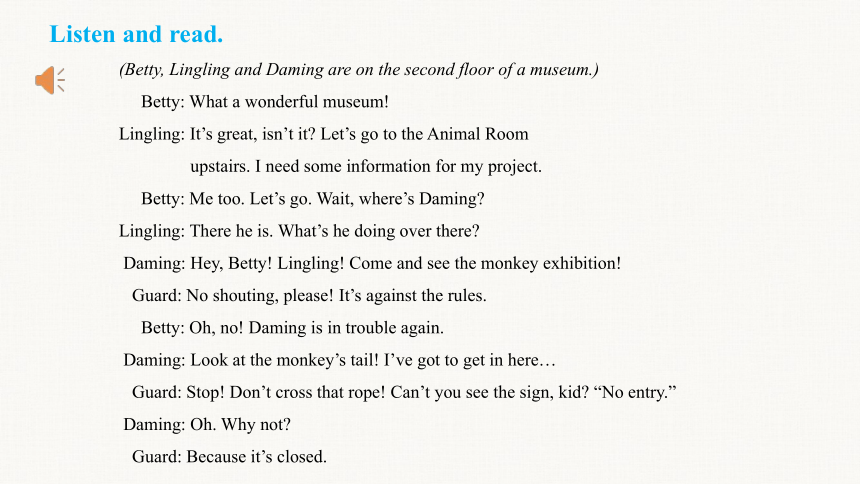
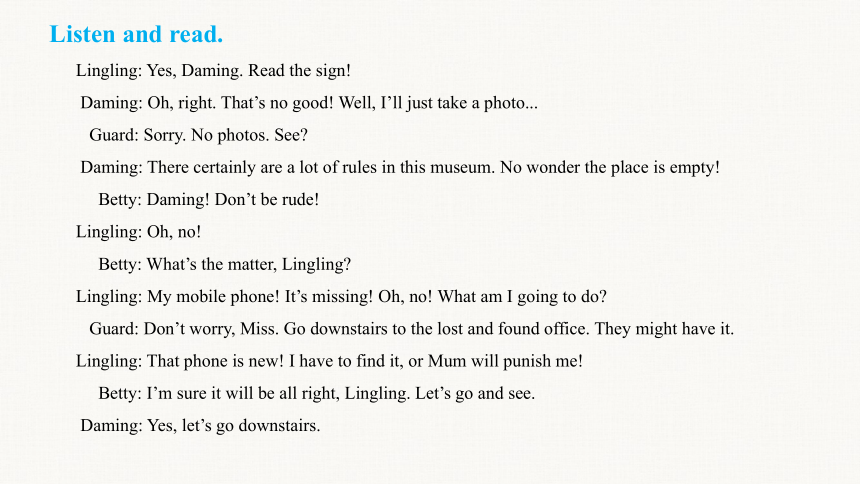
文档简介
(共33张PPT)
Module 5 Museums
外研九年级上册 Module 5
Unit 1 Don’t cross that rope!
Warming up
We can see many signs around us. Do you know their English meanings
No smoking!
No parking!
No swimming!
No photos!
No entry!
No littering!
No touching!
No left turn!
Warming up
No shouting!
No running!
No burning!
No climbing!
Warming up
Match the signs with the rules.
1 Don’t touch.
2 No smoking.
3 No shouting.
4 No photos.
a
b
c
d
Listening and vocabulary
1
Now work in pairs. Tell your partner the rules.
You are not allowed to take photos.
You are not allowed to shout.
You are not allowed to touch it.
You are not allowed to smoke.
Listening and vocabulary
Listen and answer the questions.
1 Where did Lingling find the guide
2 How many people are going to the museum on Saturday
She got it from the Internet.
Three (Betty, Lingling and Daming).
2
Listening and vocabulary
Tapescript
I’m very excited about our visit to the museum on Saturday.
I’m looking forward to it too. If you want to know what to see,
look at the guide. I got it from the Internet. They’ve got an interesting Animal Room, with lots of exhibitions.
Betty:
Lingling:
Great! I especially want to see that.
So do I. Our homework is to write about our favourite museum,
and this one will be great for our report.
Exactly!
Have you invited anyone else to come with us on Saturday
Yes, I have. Daming is coming.
Betty:
Lingling:
Betty:
Lingling:
Betty:
Listen and read.
3
Listening and vocabulary
2. What did the guard stop Daming from doing
3. Where did the guard advise them to go after Lingling lost her mobile phone
He stopped Daming from crossing that rope.
He advised them to go downstairs to the lost and found office.
Answer the questions below.
1. Why did Lingling go to the Animal Room upstairs
They went to the Animal Room upstairs because she needed some information for her project.
(Betty, Lingling and Daming are on the second floor of a museum.)
Betty: What a wonderful museum!
Lingling: It’s great, isn’t it Let’s go to the Animal Room
upstairs. I need some information for my project.
Betty: Me too. Let’s go. Wait, where’s Daming
Lingling: There he is. What’s he doing over there
Daming: Hey, Betty! Lingling! Come and see the monkey exhibition!
Guard: No shouting, please! It’s against the rules.
Betty: Oh, no! Daming is in trouble again.
Daming: Look at the monkey’s tail! I’ve got to get in here…
Guard: Stop! Don’t cross that rope! Can’t you see the sign, kid “No entry.”
Daming: Oh. Why not
Guard: Because it’s closed.
Listen and read.
Lingling: Yes, Daming. Read the sign!
Daming: Oh, right. That’s no good! Well, I’ll just take a photo...
Guard: Sorry. No photos. See
Daming: There certainly are a lot of rules in this museum. No wonder the place is empty!
Betty: Daming! Don’t be rude!
Lingling: Oh, no!
Betty: What’s the matter, Lingling
Lingling: My mobile phone! It’s missing! Oh, no! What am I going to do
Guard: Don’t worry, Miss. Go downstairs to the lost and found office. They might have it.
Lingling: That phone is new! I have to find it, or Mum will punish me!
Betty: I’m sure it will be all right, Lingling. Let’s go and see.
Daming: Yes, let’s go downstairs.
Listen and read.
Now check (√) the rules mentioned in the conversation.
a
f
e
c
b
d
√
√
√
Write down what you cannot do in the museum.
No shouting.
No (taking) photos.
No entry.
No touching.
4
Listening and vocabulary
Complete the passage with the words in the box.
Lingling and Betty needed some information for their projects, so they wanted to go (1) _________ to the Animal Room, but Daming got into trouble at the monkey (2) _________. Daming broke the (3) _____ by shouting and trying to cross the (4) _____ when he planned to see a monkey with a long (5) _____. Then they discovered that Lingling’s mobile phone was (6) _______. The guard told them to go (7) __________ to the lost and found office. Lingling has to find her phone, or her mother will (8) _______ her.
upstairs
exhibition
rules
rope
tail
missing
downstairs
punish
downstairs exhibition missing punish rope rules tail upstairs
5
Listening and vocabulary
1. let’s与let us的用法:
①let’s用于提出建议,包括听话者在内,在“Let’s”句型中,反意疑问部分要用shall we或shan’t we。如:
Let’s try it again. 让我们再试试吧。(包括对方)
Let’s go to see the film, shall we 咱们去看电影,好吗?(包括对方)
Language points
②let us表示请求对方允许做某事,不包括听话者在内,在“Let us”句型中,反意疑问部分要用“will/won’t you”,表示请求。如:
Let us know the time of your arrival. 告诉我们你到达的时间。(不包括对方)
Let us do it by ourselves. 让我们自己做这件事情吧。(不包括对方)
Language points
2. missing,lost与gone的用法:
①lost意为“丢失”,含有“难以找回”的意思,可作定语、表语或宾语补足语。如:
Look! She is looking for her lost key. 看! 她正在寻找丢失的钥匙。
Lost time will never be found again. 失去的时间永远不会再被找回。
②missing意为“失踪了,不见了”,强调某人或物不在原处,暂时找不着了(含最终可能找到之意),可作定语、表语或宾补。如:
They set out to look for the missing girl at once. 他们立即出发去寻找丢失的女孩。
Language points
③gone意为“(东西)没了;(时间)过去了;(人)死了”,而且语气肯定,作表语或宾语补足语,不可以作定语。如:
My fever is gone, but I still have a cough. 发烧消退了,但我仍然咳嗽。
Her grandpa is gone, so her grandma lives alone. 她的爷爷去世了,所以她奶奶独自生活。
Language points
3.What a wonderful museum! 多好的博物馆啊!
【用法详解】本句是由 what 引导的感叹句。感叹句是表示赞美、惊叹等情感的句子,通常由 what 或 how 引导。what 修饰名词(短语),how 修饰形容词或副词。
Language points
What +a/an + adj. +可数名词单数 ( +主语+谓语+其他)! What a beautiful place it is! 多美丽的一个地方啊!
What + adj. + 可数名词复数
( +主语+谓语+其他)! What interesting books! 多有趣的书啊!
What + adj. +不可数名词 ( +主语+谓语+其他)! What useful advice you give me! 你给我出了多么有用的建议啊!
Language points
How + adj. /adv. + (主语+谓语+其他)! How fast the technology develops!
科技发展得真快啊!
How + adj. + a/an + 可数名词单数 ( +主语+谓语+其他)! How important a decision it is!
这是多么重要的一个决定啊!
②how引导的感叹句:
Language points
—______ fast China is developing!
—Yes, we are so lucky to live in such a great country.
A. What B. What a C. How D. How a
解析:其结构为:How + adv. + 主语+谓语!
Language points
No shouting, please ! 请勿喧哗!
No photos. 请勿拍照。
Don’t cross that rope! 不要越过那条绳子!
这些语句表达的都是“禁止做某事”。
要表达这一意思可以采用以下几种结构。
1) no +动名词,例如: No joking!
2) no +名词,例如:No entry!
3) 祈使句,例如:Don’t make any noise.
4.
Language points
5. No wonder the place is empty! 难怪这个地方人不多。
wonder的用法
(1)作名词,意为“奇迹;奇观”。
The Great Wall is one of the seven wonders of the world.
长城是世界上七大奇迹之一。
① It’s a wonder that … 意为“奇怪的是……”。
如:It’s a wonder that she is still alive. 奇怪的是她还活着。
Language points
②It's no wonder that … 意为“难怪……”。如:
It's no wonder that they won't come. 难怪他们没有来。
(2)作及物动词,意为“想知道;对……感到怀疑”
① 后接 who , what , why , where 等引导的宾语从句。
例如:I wonder who she is.我想知道她是谁。
Language points
②后接 that 引导的宾语从句,表示“感到惊奇;对……感到惊讶”, that 常可省去。例如:
I wonder (that) she has won the race. 我对她赢了比赛感到惊讶。
③后接动词不定式短语或“疑问词+不定式”构成的短语。例如:
I'm just wondering how to do it. 我正想知道该怎样做那件事。
Language points
Stress 重读
英语句子一般由多个单词构成,这些单词的重读一般遵循以下规律:名词、形容词、数词、动词、副词、代词和表达强烈思想感情的感叹词需要重读;人称代词、连词、冠词、介词、以及少数系动词和助动词等主要起语法作用的单词一般不重读(当然有少数例外)。
Pronunciation and speaking
1. No shouting, please! It’s against the rules.
2. Because it’s closed.
3. There certainly are a lot of rules in this museum.
Listen and underline the words the speaker stresses.
Now listen again and repeat.
6
Pronunciation and speaking
— Must we keep quiet in the classroom
— Yes. No shouting in the classroom.
Work in pairs. Discuss the rules in your classroom.
—Can we eat in the classroom
—No. No food and drink is to be taken into the classroom.
7
Pronunciation and speaking
1.We have learnt to listen and understand the sentences giving instructions.
2.We have known how to use imperative sentences and modal verbs to give instructions.
3.We have grasped some words and expressions involving this unit.
Summary
Homework
1. Recite the new words.
2. Finish the task in KESHI A JIHUA .
Thanks
Class is over! Bye!
外研九年级上册 Module 5
Module 5 Museums
外研九年级上册 Module 5
Unit 1 Don’t cross that rope!
Warming up
We can see many signs around us. Do you know their English meanings
No smoking!
No parking!
No swimming!
No photos!
No entry!
No littering!
No touching!
No left turn!
Warming up
No shouting!
No running!
No burning!
No climbing!
Warming up
Match the signs with the rules.
1 Don’t touch.
2 No smoking.
3 No shouting.
4 No photos.
a
b
c
d
Listening and vocabulary
1
Now work in pairs. Tell your partner the rules.
You are not allowed to take photos.
You are not allowed to shout.
You are not allowed to touch it.
You are not allowed to smoke.
Listening and vocabulary
Listen and answer the questions.
1 Where did Lingling find the guide
2 How many people are going to the museum on Saturday
She got it from the Internet.
Three (Betty, Lingling and Daming).
2
Listening and vocabulary
Tapescript
I’m very excited about our visit to the museum on Saturday.
I’m looking forward to it too. If you want to know what to see,
look at the guide. I got it from the Internet. They’ve got an interesting Animal Room, with lots of exhibitions.
Betty:
Lingling:
Great! I especially want to see that.
So do I. Our homework is to write about our favourite museum,
and this one will be great for our report.
Exactly!
Have you invited anyone else to come with us on Saturday
Yes, I have. Daming is coming.
Betty:
Lingling:
Betty:
Lingling:
Betty:
Listen and read.
3
Listening and vocabulary
2. What did the guard stop Daming from doing
3. Where did the guard advise them to go after Lingling lost her mobile phone
He stopped Daming from crossing that rope.
He advised them to go downstairs to the lost and found office.
Answer the questions below.
1. Why did Lingling go to the Animal Room upstairs
They went to the Animal Room upstairs because she needed some information for her project.
(Betty, Lingling and Daming are on the second floor of a museum.)
Betty: What a wonderful museum!
Lingling: It’s great, isn’t it Let’s go to the Animal Room
upstairs. I need some information for my project.
Betty: Me too. Let’s go. Wait, where’s Daming
Lingling: There he is. What’s he doing over there
Daming: Hey, Betty! Lingling! Come and see the monkey exhibition!
Guard: No shouting, please! It’s against the rules.
Betty: Oh, no! Daming is in trouble again.
Daming: Look at the monkey’s tail! I’ve got to get in here…
Guard: Stop! Don’t cross that rope! Can’t you see the sign, kid “No entry.”
Daming: Oh. Why not
Guard: Because it’s closed.
Listen and read.
Lingling: Yes, Daming. Read the sign!
Daming: Oh, right. That’s no good! Well, I’ll just take a photo...
Guard: Sorry. No photos. See
Daming: There certainly are a lot of rules in this museum. No wonder the place is empty!
Betty: Daming! Don’t be rude!
Lingling: Oh, no!
Betty: What’s the matter, Lingling
Lingling: My mobile phone! It’s missing! Oh, no! What am I going to do
Guard: Don’t worry, Miss. Go downstairs to the lost and found office. They might have it.
Lingling: That phone is new! I have to find it, or Mum will punish me!
Betty: I’m sure it will be all right, Lingling. Let’s go and see.
Daming: Yes, let’s go downstairs.
Listen and read.
Now check (√) the rules mentioned in the conversation.
a
f
e
c
b
d
√
√
√
Write down what you cannot do in the museum.
No shouting.
No (taking) photos.
No entry.
No touching.
4
Listening and vocabulary
Complete the passage with the words in the box.
Lingling and Betty needed some information for their projects, so they wanted to go (1) _________ to the Animal Room, but Daming got into trouble at the monkey (2) _________. Daming broke the (3) _____ by shouting and trying to cross the (4) _____ when he planned to see a monkey with a long (5) _____. Then they discovered that Lingling’s mobile phone was (6) _______. The guard told them to go (7) __________ to the lost and found office. Lingling has to find her phone, or her mother will (8) _______ her.
upstairs
exhibition
rules
rope
tail
missing
downstairs
punish
downstairs exhibition missing punish rope rules tail upstairs
5
Listening and vocabulary
1. let’s与let us的用法:
①let’s用于提出建议,包括听话者在内,在“Let’s”句型中,反意疑问部分要用shall we或shan’t we。如:
Let’s try it again. 让我们再试试吧。(包括对方)
Let’s go to see the film, shall we 咱们去看电影,好吗?(包括对方)
Language points
②let us表示请求对方允许做某事,不包括听话者在内,在“Let us”句型中,反意疑问部分要用“will/won’t you”,表示请求。如:
Let us know the time of your arrival. 告诉我们你到达的时间。(不包括对方)
Let us do it by ourselves. 让我们自己做这件事情吧。(不包括对方)
Language points
2. missing,lost与gone的用法:
①lost意为“丢失”,含有“难以找回”的意思,可作定语、表语或宾语补足语。如:
Look! She is looking for her lost key. 看! 她正在寻找丢失的钥匙。
Lost time will never be found again. 失去的时间永远不会再被找回。
②missing意为“失踪了,不见了”,强调某人或物不在原处,暂时找不着了(含最终可能找到之意),可作定语、表语或宾补。如:
They set out to look for the missing girl at once. 他们立即出发去寻找丢失的女孩。
Language points
③gone意为“(东西)没了;(时间)过去了;(人)死了”,而且语气肯定,作表语或宾语补足语,不可以作定语。如:
My fever is gone, but I still have a cough. 发烧消退了,但我仍然咳嗽。
Her grandpa is gone, so her grandma lives alone. 她的爷爷去世了,所以她奶奶独自生活。
Language points
3.What a wonderful museum! 多好的博物馆啊!
【用法详解】本句是由 what 引导的感叹句。感叹句是表示赞美、惊叹等情感的句子,通常由 what 或 how 引导。what 修饰名词(短语),how 修饰形容词或副词。
Language points
What +a/an + adj. +可数名词单数 ( +主语+谓语+其他)! What a beautiful place it is! 多美丽的一个地方啊!
What + adj. + 可数名词复数
( +主语+谓语+其他)! What interesting books! 多有趣的书啊!
What + adj. +不可数名词 ( +主语+谓语+其他)! What useful advice you give me! 你给我出了多么有用的建议啊!
Language points
How + adj. /adv. + (主语+谓语+其他)! How fast the technology develops!
科技发展得真快啊!
How + adj. + a/an + 可数名词单数 ( +主语+谓语+其他)! How important a decision it is!
这是多么重要的一个决定啊!
②how引导的感叹句:
Language points
—______ fast China is developing!
—Yes, we are so lucky to live in such a great country.
A. What B. What a C. How D. How a
解析:其结构为:How + adv. + 主语+谓语!
Language points
No shouting, please ! 请勿喧哗!
No photos. 请勿拍照。
Don’t cross that rope! 不要越过那条绳子!
这些语句表达的都是“禁止做某事”。
要表达这一意思可以采用以下几种结构。
1) no +动名词,例如: No joking!
2) no +名词,例如:No entry!
3) 祈使句,例如:Don’t make any noise.
4.
Language points
5. No wonder the place is empty! 难怪这个地方人不多。
wonder的用法
(1)作名词,意为“奇迹;奇观”。
The Great Wall is one of the seven wonders of the world.
长城是世界上七大奇迹之一。
① It’s a wonder that … 意为“奇怪的是……”。
如:It’s a wonder that she is still alive. 奇怪的是她还活着。
Language points
②It's no wonder that … 意为“难怪……”。如:
It's no wonder that they won't come. 难怪他们没有来。
(2)作及物动词,意为“想知道;对……感到怀疑”
① 后接 who , what , why , where 等引导的宾语从句。
例如:I wonder who she is.我想知道她是谁。
Language points
②后接 that 引导的宾语从句,表示“感到惊奇;对……感到惊讶”, that 常可省去。例如:
I wonder (that) she has won the race. 我对她赢了比赛感到惊讶。
③后接动词不定式短语或“疑问词+不定式”构成的短语。例如:
I'm just wondering how to do it. 我正想知道该怎样做那件事。
Language points
Stress 重读
英语句子一般由多个单词构成,这些单词的重读一般遵循以下规律:名词、形容词、数词、动词、副词、代词和表达强烈思想感情的感叹词需要重读;人称代词、连词、冠词、介词、以及少数系动词和助动词等主要起语法作用的单词一般不重读(当然有少数例外)。
Pronunciation and speaking
1. No shouting, please! It’s against the rules.
2. Because it’s closed.
3. There certainly are a lot of rules in this museum.
Listen and underline the words the speaker stresses.
Now listen again and repeat.
6
Pronunciation and speaking
— Must we keep quiet in the classroom
— Yes. No shouting in the classroom.
Work in pairs. Discuss the rules in your classroom.
—Can we eat in the classroom
—No. No food and drink is to be taken into the classroom.
7
Pronunciation and speaking
1.We have learnt to listen and understand the sentences giving instructions.
2.We have known how to use imperative sentences and modal verbs to give instructions.
3.We have grasped some words and expressions involving this unit.
Summary
Homework
1. Recite the new words.
2. Finish the task in KESHI A JIHUA .
Thanks
Class is over! Bye!
外研九年级上册 Module 5
同课章节目录
- Module 1 Wonders of the world
- Unit 1 It's more than 2,000 years old.
- Unit 2 The Grand Canyon was not just big.
- Unit 3 Language in use
- Module 2 Public holidays
- Unit 1 My family always go somewhere interesting a
- Unit 2 We have celebrated the festival since the f
- Unit 3 Language in use
- Module 3 Heroes
- Unit 1 She trained hard,so she became a great play
- Unit 2There were few doctors, so he had to work ve
- Unit 3 Language in use
- Module 4 Home alone
- Unit 1 I can look after myself, although it won’t
- Unit 2 I became so bored with their orders that I
- Unit 3 Language in use
- Module 5 Museums
- Unit 1 Don't cross that rope!
- Unit 2 If you ever go to London, make sure you vis
- Unit 3 Language in use
- Module 6 Problems
- Unit 1 If I start after dinner, I'll finish it be
- Unit 2 If you tell him the truth now, you will sho
- Unit 3 Language in use
- Revision Module A
- Module 7 Great books
- Unit 1 We're still influenced by Confucius's idea
- Unit 2 It is still read and loved.
- Unit 3 Language in use
- Module 8 Sports life
- Unit 1 Daming wasn't chosen for the team last time
- Unit 2 He was invited to competitions around the w
- Unit 3 Language in use
- Module 9 Great inventions
- Unit 1 Will computers be used more than books in t
- Unit 2 Will books be replaced by the Internet?
- Unit 3 Language in use
- Module 10 Australia
- Unit 1 I have some photos that I took in Australia
- Unit 2 The game that they like most is Australian
- Unit 3 Language in use
- Module 11 Photos
- Unit 1 He's the boy who won the photo competition
- Unit 2 The photo which we liked best was taken by
- Unit 3 Language in use
- Module 12 Save our world
- Unit 1 If everyone starts to do something, the wor
- Unit 2 Repeat these three words daily: reduce, reu
- Unit 3 Language in use
- Revision Module B
